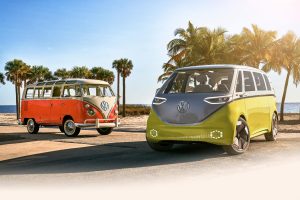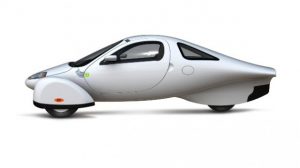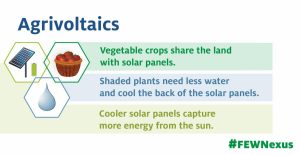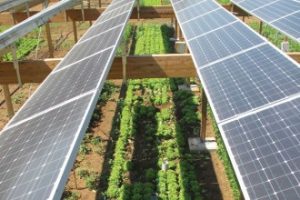In This Issue
- Flanigan’s Eco-Logic: What a Year!
- Redefining National Progress
- Electrifying Cars and Pick-Ups
- Never-Charge Electric Vehicles
- Free Mass Transit in Kansas City
- Industrial Climate Break-Throughs
- First Commercial Electric Aviation
- Agrivoltaics and Shared Light
- Vermont’s Local Energy Marketplace
- Copenhagen’s Community Fruit Trees
- EcoMotion Team Updates

Flanigan’s EcoLogic: What a Year!
Optimists like me are thrilled with 2019. There has clearly been huge progress in raising awareness about planet care, capped by Time Magazine naming young Greta Thunberg as its Person of the Year. The Climate Crisis as it is now known, is painfully real and understood globally.
Now it’s time for action and more of it from each of us. There are easy steps in each of our homes and daily routines to care for our planet. Often these things save money too. At EcoMotion, we’re pleased to serve businesses and school districts and cities that want to do more to save money and to protect our planet and civilization. The years 2020 to 2030 are now known as the defining decade. Go for it! Let’s roll.
There are so many potent indicators of progress: EcoMotion’s world of solar is exploding in the best ways! Low costs, high demand… lots of trained and talented professionals. Solar is booming and now with storage at its side. This distributed revolution enables new, disruptive utility configurations. EcoMotion is coupling solar and storage to provide carbon-free resiliency solutions, microgrids. Electric vehicles and electric buses are poised to be distributed storage assets adding to this new electricity paradigm. Ancillary power markets are on the horizon as new revenue streams. All this as buildings are electrifying too. Just as we have hybrid cars, we now have hybrid buildings… with net zero highly in vogue!
The news is crackling with announcements of electric cars entering the market. Tesla’s Model 3 has shattered records. According to Car and Driver there are now 16 all-electric EVs in the American market with more on the way from Ford, Mercedes Porsche, Volvo, and others.
How about “never-charge cars?” Thanks to super efficiency solar panels and storage on board, these vehicles such as the Aptera Series 2 can run completely off the grid. There’s even an RV that’s been produced that never needs to refuel. Cut the cord! Not to be outdone, now more and more ferries are electric, and now we can fly electric too! The nation’s first commercial electric aviation commenced in 2019.
Take a look at industry: The Norwegian oil conglomerate, Equinor plans to use offshore wind to power oil rigs. Steel mills in America are going electric. Alcoa has developed a smelting process to produce aluminum that emits pure oxygen, eliminating direct greenhouse gas emissions. The first-of-a-kind metal will be shipped and sold to Apple for its products. Bill Gates made headlines this year with his solar concentrating system that raises temperatures high enough for industry and making cement. Every part of the greenhouse gas emission puzzle is addressed with extraordinary innovation.
Now banks are shifting to sustainability… big time. Money talks. Goldman Sachs announced in December that it will no longer finance new oil drilling or exploration in the Arctic. Environmental concerns spurred its policy, citing “potential impacts to critical natural habitats for endangered species” and the effects on indigenous communities. In response to advocacy efforts by the Gwich’in Steering Committee, the Sierra Club, and the Rainforest Action Network, 13 European and Australian banks have committed to no longer finance new onshore and offshore Arctic drilling.
Just this month the European Investment Bank decided to stop funding most oil and coal projects by 2021… part of a bid to be the world’s first climate bank. Bill McKibben called it a “truly amazing win,” the world’s largest public bank bowing to public pressure. It now recognizes that funding fossil fuels must end. Specifically, the European Investment Bank will not fund any power generation project that creates more than 250 grams of carbon per kWh… effectively banning traditional coal, oil, and gas plants absent carbon capture and storage or combined heat and power to maximize thermodynamic efficiency.
The good news goes on and on. Female world leaders are questioning how to measure their nation’s well-being. It’s not about endless growth. It is about forging a higher quality of life. Coal miner’s kids in Colorado are installing solar panels. A steel mill there is powered by the sun. Wind energy in Iowa has spurred economic development, attracting Good, Facebook, and Microsoft. In Kansas, access to carbon-free wind was key in bringing a Mars plant. The University of California has divested from fossil fuels. And this past week we celebrated the installation of a million solar roofs in California… a goal set by Governor Arnold Schwarzenegger in 2006 that seemed hugely aspirational. Now our sights are on one million, distributed energy storage systems.
2019 has been a year of advances, big and small, profound and incremental. Bring on 2020.




 In early December, Kansas City became the first major American city to have fare-free public transit. It’s light-rail system was already free; now council there has voted unanimously to make city bus routes completely free as well. The free service is expected to cost the city about $8 million each year. The resolution was pitched as a major help for low-income residents who rely on transit to commute to work.
In early December, Kansas City became the first major American city to have fare-free public transit. It’s light-rail system was already free; now council there has voted unanimously to make city bus routes completely free as well. The free service is expected to cost the city about $8 million each year. The resolution was pitched as a major help for low-income residents who rely on transit to commute to work.







